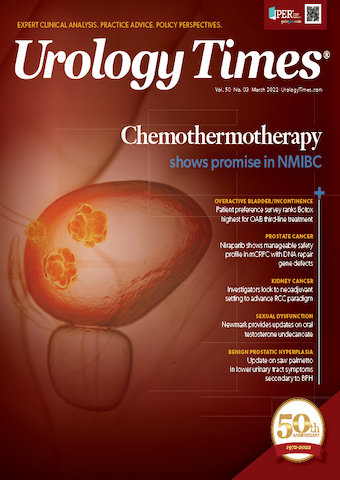Publication
Article
Urology Times Journal
What will be the next GOAT for bladder cancer?
Author(s):
"The future is bright for immunotherapy in bladder cancer," writes Michael S. Cookson, MD, MMHC.
Michael S. Cookson, MD, MMHC

Regarding the disease state of bladder cancer, we are now fully immersed in the discovery of new therapeutics, particularly as they pertain to immunotherapy. Indeed, these are exciting times for immunotherapy and its use in advanced and metastatic bladder cancer. However, as we look back over the past 50 years, we would be remiss if we didn’t reflect on the historic success of Bacillus Calmette-Guerin (BCG) therapy, the “greatest of all time (GOAT)” when it comes to treatment of high-risk non–muscle invasive bladder cancer. Based on a variety of initial observations and small reports demonstrating the anticancer activity of BCG therapy, Canadian urologist Alvaro Morales, MD, FRCSC, had the foresight to place BCG within the bladder.1 And in 1976, he published the first use of BCG therapy directed at “superficial” bladder cancer.2 Based on these early results in only 7 patients, the National Cancer Institutefunded 2 randomized controlled trials to test the effectiveness of the combined BCG regimen in patients with “superficial” bladder cancer, one trial by Southwest Oncology Group (now SWOG) led by Donald Lamm, MD, FACS, and the other at Memorial Sloan Kettering Cancer Center.3,4
Both studies demonstrated that BCG markedly reduced tumor recurrence compared with transurethral surgery alone, confirming Morales’ early observations. Subsequently, many studies have proved the benefit of BCG in eradicating carcinoma in situ (CIS) of the bladder, delaying progression to muscle invasion, and improving the survival of patients with high-risk non–muscle-invasive bladder cancer. It has also proved superior to intravesical chemotherapy.2
In 1990, the FDA approved the use of intravesical BCG. Now, almost 50 years after the first report, BCG therapy remains the gold-standard treatment of high-grade, high-risk noninvasive bladder cancer. The response rates for truly high-risk patients are in the range of 70% to 80%, but for those who recur after receiving BCG, the options are more limited and radical cystectomy becomes a choice for those who are fit and willing. It was in this context that another immune-based therapy, pembrolizumab (Keytruda), was tested and demonstrated benefit in this BCG-unresponsive state. In this setting, approximately 40% of patients may have their CIS eradicated with PD-1 immunotherapy, and in many the response is durable.5
In muscle-invasive bladder cancer, immunotherapy is being trialed as an alternative to chemotherapy in the neoadjuvant space among patients who are ineligible for platinum-based chemotherapy.6 Additionally, we now have FDA-approved adjuvant maintenance therapy following radical cystectomy with nivolumab (Opdivo) among patients with locally advanced pathologic features, regardless of prior neoadjuvant chemotherapy, nodal involvement, or PD-L1 status.7
Finally, among patients with metastatic bladder cancer, immunotherapy’s benefits are now also well established. Findings from several trials have consistently demonstrated that checkpoint inhibitors are active in this disease state, with response rates ranging from 15% to 30% depending on the study and line of treatment.6 Checkpoint inhibitors have also improved survival in the second-line setting, including in patients whose cancer persisted or progressed after prior platinum-based chemotherapy treatment. So the future is bright for immunotherapy in bladder cancer, and we look forward to the next 50 years of discovery and hope for the GOAT’s successors, with cancer eradication and bladder preservation as our primary goals.
References
1. Herr HW, Morales A. History of bacillus Calmette-Guerin and bladder cancer: an immunotherapy success story. J Urol. 2008;179(1):53-56. doi:10.1016/j.juro.2007.08.122
2. Morales A, Eidinger D, Bruce AW. Intracavitary bacillus Calmette-Guerin in the treatment of superficial bladder tumors. J Urol. 1976;116(2):180-183. doi:10.1016/s0022-5347(17)58737-6
3. Lamm DL, Thor DE, Harris SC, Reyna JA, Stogdill VD, Radwin HM. Bacillus Calmette-Guerin immunotherapy of superficial bladder cancer. J Urol. 1980;124(1):38-40. doi:10.1016/s0022-5347(17)55282-9
4. Camacho FJ, Pinsky CM, Herr HW, et al. Treatment of superficial bladder cancer with intra-vesical BCG. Proc Am Soc Clin Oncol. 1980;21(3):359
5. Balar AV, Kamat AM, Kulkarni GS, et al. Pembrolizumab monotherapy for the treatment of high-risk non-muscle-invasive bladder cancer unresponsive to BCG (KEYNOTE-057): an open-label, single-arm, mutlicentre, phase 2 study. Lancet Oncol. 2021;22(7):919-930. doi:10.1016/S1470-2045(21)00147-9
6. Jang A, Adler DM, Rauterkus GP, Bilen MA, Barata PC. Immunotherapies in genitourinary oncology: where are we now? Where are we going? Cancers (Basel). 2021;13(20):5065. doi:10.3390/cancers13205065
7. Powles T, Park SH, Voog E, et al. Avelumab maintenance therapy for advanced or metastatic urothelial carcinoma. N Engl J Med. 2020;383(13):1218-1230. doi:10.1056/NEJMoa2002788

































